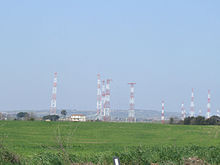Shortwave transmitter


A shortwave transmitter is a transmission system for electromagnetic waves with frequencies in the shortwave range , i.e. in the frequency range between 3 MHz and 30 MHz. Shortwave transmitters often have several modes of operation, usually amplitude modulation (AM) and single sideband modulation (SSB). The latter enables a greater range with the same transmission power, but requires more complicated demodulation . Shortwave transmitters for broadcasting purposes are mostly designed for amplitude modulation, whereby their RF output power can be over 500 kilowatts depending on the design and very high or intercontinental ranges can be achieved.
Transmitting antennas
As a transmitting antenna for the shortwave range , i.e. in the frequency range between 3 MHz and 30 MHz, either omnidirectional antennas in the form of small self-radiating masts , T-antennas or trap antennas , as well as directional antennas in the form of logarithmic-periodic antennas and dipole walls are used . The latter consist of several horizontally or vertically polarized dipoles suspended between earthed steel structures and have a strong directional effect. A rotation of the emission direction is also possible within certain limits by means of a suitable detuning circuit.
In some systems, such as the new shortwave center in Nauen ( large radio station Nauen ) or in Moosbrunn in Austria ( shortwave transmitter Moosbrunn ), there are turntable antennas and rotatable shortwave dipole wall antennas with which a particularly strong directional effect and thus a further increase in range can be achieved. The so-called ALISS antennas, which were developed in France and can be found in the Issoudun shortwave transmitter , are also rotatable and have a strong directional effect.
Since the propagation conditions in the shortwave range often fluctuate depending on the radio weather or the number of sunspots , it makes sense to choose a frequency that is optimal for the respective conditions, which is why, if necessary, you should switch between the transmission frequencies several times a day. For this reason, many shortwave transmitters are designed in such a way that a faster frequency change is possible, with more modern designs without having to stop transmitting, although in the past it was often switched to another transmitter.
Shortwave transmitters for radiotelephone services of various types such as for the communication of messages , aviation radio , marine radio , radio telegraphy or amateur radio often have several operating modes ( modulation types ) such as u. a. Amplitude modulation (AM) and single sideband modulation (SSB), the latter allowing a greater range with the same transmission power but requiring more complicated demodulation .
One of the largest existing shortwave transmitters is the Wertachtal shortwave transmitter , one of the largest former shortwave transmitters was located in the Jülich shortwave center . The transmit power may vary by type in a single short-wave transmitter 500 kW amount when a plurality of stations are connected together, the transmission power so that larger transmission equipment is added, accordingly, with several large transmission towers at 2000 kW and can radiate their program.
Well-known transmission systems
Active KW transmitter systems
- Major radio station Nauen (Germany)
- Shortwave transmitter Moosbrunn (Austria)
- Shortwave transmitter in Issoudun (France)
- Shortwave transmitter Rimavská Sobota (Slovakia)
- Shortwave transmitter Litomyšl (Czech Republic)
- Short wave transmitter Udon Thani (Thailand)
- WRMI shortwave transmitter (Florida, USA)
Inactive KW transmission systems
- Shortwave transmission center Prato Smeraldo (Italy)
- Caltanissetta transmitter (Italy) - no longer active in broadcasting
- Short wave transmitter Pori (Finland)
- Transmitter system Veľké Kostoľany (Slovakia)
- Cyclops relay station (Malta)
Former KW broadcasting systems
- Shortwave transmitter in Wertachtal (Germany)
- Shortwave Center Jülich (Germany)
- Transmitter Königs Wusterhausen (Germany)
- Norddeich Radio (Germany)
- Rügen Radio (Germany)
- Shortwave transmitter Fleckendorf (Austria)
- Short wave transmitter Schwarzenburg (Switzerland)
- Shortwave transmitter Poděbrady (Czech Republic)
See also
- Shortwave broadcasting
- Antenna technology
- Medium wave transmitter
- Long wave transmitter
- Frequency band
- List of known transmitters


